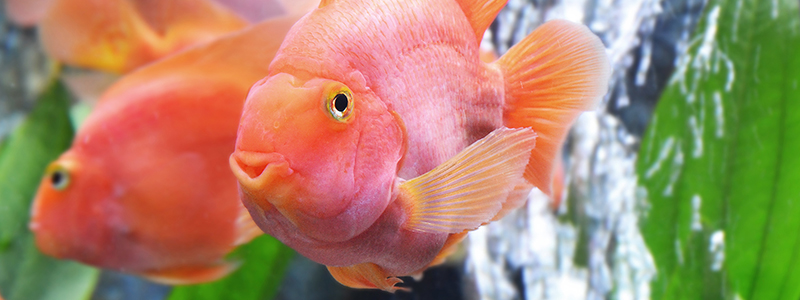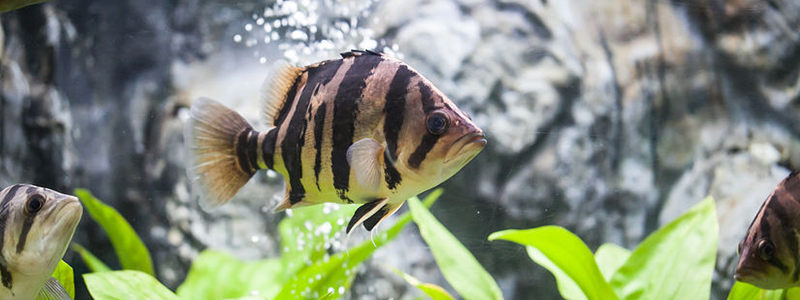Quick Stats
- Family: Cichlidae
- Scientific Name: none (Hybrid)
- Care level: Moderate
- Temperament: Peaceful
- Diet: Omnivorous
- Water conditions: Freshwater, 22 – 28 degrees Celcius (72 – 82F), 6.5 – 7 pH
- Max Size: 20 centimeters (8 inches)
- Minimum tank size (as an adult): 158 Liters (42 gallons)
Brief Overview: Blood Parrot Fish Care
Also known as the Blood Parrot Cichlid or Parrot Cichlid, the Blood Parrot is a man-made hybrid cichlid not found in the wild. This hybrid was created in Taiwan in 1986 and was most likely a cross between the Midas Cichlid (Amphilophus citrinellus) and the Redhead Cichlid (Vieja melanura). Since then, different cichlid crosses have resulted in many variations of the Blood Parrot. The Blood Parrot should not be confused with naturally-occurring parrot cichlids of South and Central America or the unrelated saltwater parrotfish species. South American Cichlids naturally inhabit the dense vegetation of streams, creeks, and rivers in the Amazon River Basin.
Blood Parrots are named for the beak-like shape of their mouth and head. This breed has a round body and large eyes. Blood Parrots are usually bright orange in coloration but can occur in shades of red, yellow, and gray. Other colors are produced via the controversial practice of injecting dye into individual fish, but this method can reduce life expectancy. Another controversial modification involves cutting the tail while the fish are small, causing the individuals to grow in a heart shape. These fish are sold under the name Heart Parrot, but the exposure to this inhumane treatment has caused the use of this alteration method to dwindle.
The hybridized nature of the Blood Parrot has led to several physical deformities. The beak-shaped mouth in many varieties is unable to fully close, and fish must compensate by crushing food with their throats. This can lead to difficulty providing proper nutrition for your fish, though some commercial foods have been specially developed for Blood Parrots. This breed can also have deformed swim bladders which cause an awkward swimming pattern, as well as unusually large or even deformed irises.
Despite the controversies and genetic deformities, Blood Parrots are a popular choice for many fishkeepers due to their peaceful temperament, bright coloration, and ability to live in a community tank. Blood Parrots are quite hardy and can be housed alone, in schools, or with other peaceful species in a range of water quality and temperatures.
Blood Parrot Fish Lifespan
Blood Parrot fish have a life expectancy of 10 to 15 years in an aquarium with excellent care and conditions.
How fast/slow should you expect your Blood Parrot fish to grow?
The Blood Parrot’s growth rate is slower than most Central American Cichlids and its fellow cichlid hybrid, the Flowerhorn. They can be expected to grow between 13 and 15 centimeters (5 – 6 inches) in the first year. After that their growth rate slows considerably more.
What’s Blood Parrot fish max size?
The maximum size of a Blood Parrot fish is usually around 20 centimeters (8 inches), but in very large tanks Blood Parrots have been reported to reach up to 25 centimeters (10 inches).
The Descendants of Parrot Fish
Since the Blood Parrot fish is a hybrid type of cichlid, there are numerous variations based on which parent species are crossed the produce them. Here are some other popular Cichlid species.
Midas Cichlid: This species is most likely one of the original parent species used to create the Blood Parrot hybrid. Midas Cichlids are heavily built and territorial, with powerful jaws and sharp teeth, and are named for their yellowish coloration.
Redhead Cichlid: This large cichlid is native to Central America and is one of the most colorful cichlid species. Males may display metallic blue, green, orange, and pink colorations along their flank. This species is most likely one of the parent species of both the Blood Parrot and Flowerhorn hybrids.
Red Devil Cichlid: Native to Central America, the Red Devil Cichlid is grey to greyish-green with black pigmentation in bands or spots common. They can also exhibit pink, red, or white coloration.
Blood Parrot Fish Diet & Feeding
Blood Parrots are omnivorous, and feeding can be difficult due to their small, often deformed, mouths.
Blood Parrot fish need to be monitored to ensure they are eating. Their deformed mouths and awkward swimming gait make them poorly equipped to compete with other fish for food.
What do Blood Parrot fish eat in the wild?
Blood Parrot fish do not occur naturally in the wild, and due to their genetic deformities do not live long in the wild even if released. The Central and South American cichlid species used to create the Blood Parrot feed on a wide variety of foods including plants, mollusks, crustaceans, and small fish.
What foods are recommended for Blood Parrot fish?
In an aquarium setting, Blood Parrots should be fed a small pelleted food that fits easily in their small mouths. Blood Parrots may have trouble eating from the surface and may require a sinking pellet. Fresh, frozen, and flake foods are all acceptable forms of nutrition for your Blood Parrot fish.
A balanced diet can include occasional brine shrimp, blood worms, and spirulina. Freeze-dried forms of these treats are recommended over live foods to avoid possible bacterial or parasitic infections being introduced into your tank.
Feeding thawed frozen peas weekly can help with swimbladder issues commonly found in Blood Parrot fish.
Blood Parrot Fish Tank Setup
Like all fish, Blood Parrots thrive best in a tank that resembles their natural habitat and suits their needs.
A brief overview of natural habitat
Blood Parrot fish are descended from Central and South American Cichlids found in the streams and rivers of the Amazon River Basin. These freshwater fish prefer heavily vegetated areas with driftwood bogs.
Blood Parrot Fish Tank size
Blood Parrots have a minimum tank requirement of 158 liters (42 gallons) for a single fish but prefer a larger community tank.
Blood Parrot Fish Water Conditions
Blood Parrot fish are typically hardy and can adapt well to a variety of water parameters, though quick changes in conditions may negatively affect them. Blood Parrots are a freshwater species that prefer a water temperature between 22 and 28 degrees Celcius (72 – 82 degrees Fahrenheit) and a slightly acidic pH somewhere between 6.5 and 7.0.
Blood Parrots, like most cichlid species, require powerful external filtration as they produce large amounts of biowaste. External filtration also leaves more room for your fish to swim around in their tank. Water changes should be performed periodically, ideally a 20% water change each week.
Tank Decorations
Blood Parrot fish are shy and require plenty of places to hide to feel comfortable in their tank. Dense vegetation, driftwood, and clay pots all make excellent spaces for a Blood Parrot to conceal itself. These fish prefer to swim along the bottom or middle of the water column and thrive on a smaller-grained substrate in which they can dig.
Blood Parrot Tank Mates
Unlike their aggressive parent cichlid species, Blood Parrots are generally peaceful. They can be kept alone or in groups, and do well in a community tank. This species gets along well with most other fish of the same size as long as they are not territorial or aggressive by nature. This fish can grow to a decent size and is omnivorous, so it will prey upon smaller fish like small tetras, goldfish, or guppies.
Some possible tank mates for Blood Parrot fish are:
- Bala Sharks
- Giant Danios
- Catfish
- Silver Dollars
- Kribensis
- Severums
- Angelfish
- Firemouth Cichlid
Blood Parrot Fish General Behavior
Blood Parrots are generally shy and peaceful, making them great choices for a community tank of other peaceful fish.

How to Keep Blood Parrot Fish Healthy
Blood Parrot fish are hardy but can be susceptible to typical ailments that affect freshwater fish, especially in environments of lower water quality.
Common diseases to look out for
When treating an individual fish, best practice calls for removing the fish to a separate “hospital tank” devoid of plants or gravel for treatment. If a disease has affected an entire tank, it is probably best to treat the tank. Read and follow the instructions for any medication or treatment for best results. Take care, as some treatments can destroy beneficial bacteria or otherwise adversely affect water quality. The carbon in your filtration system may absorb some medications, rendering treatment ineffective, and may need to be removed.
Like most aquarium fish, Blood Parrots are susceptible to ich, a disease caused by protozoa. Symptoms of ich include twitching, rubbing their bodies on various surfaces in the tank, and the appearance of white spots on the body and gills. They usually respond well to medication and heal quickly.
Swim bladder disease is a common ailment characterized by abnormal swimming patterns and trouble maintaining buoyancy. This can be caused by genetics, improper nutrition, overfeeding or constipation, a physical deformity, or even an infection. Some cases are successfully treated by feeding defrosted frozen peas.
Blood Parrots can be affected by skin flukes and other parasites, fungal infections, and bacterial infections. Know the signs and treatments of common freshwater fish diseases to catch problems early and keep your Blood Parrot fish happy and healthy.
Tips on keeping Blood Parrot Fish in good health
Blood Parrot fish are typically easy to keep healthy as long as you monitor and maintain your water composition. Perform water changes and test water quality regularly to keep ammonium and nitrite levels in check, and do not overfeed as food waste will cause these levels to spike.
Use a vacuum to clean up food waste left in the substrate by these messy eaters. Use thawed peas as a form of roughage to treat common swim bladder issues.
Keep in mind that parasites and bacteria can be introduced by new tankmates as well as live food, plants, and tank decorations.
Breeding Blood Parrot Fish
Blood Parrots are a hybrid fish and as a result, most males are sterile. While some cases of successful breeding have been reported, more often than not a female Blood Parrot’s eggs are fertilized by another closely-related Cichlid species sharing their tank. Most offspring of these pairings do not exhibit their parents’ striking coloration. Blood Parrots can also be produced by crossing the parent species together to create more hybrids.
Interesting Facts About Blood Parrot Fish
- Blood Parrots are completely man-made and do not occur in the wild.
- This fish suffers a deformity that prevents its smallmouth from closing completely.
- Parrotfish are named for the unique shape of their mouths that resemble bird beaks.
- Most male Blood Parrots are sterile.
Is a Blood Parrot Fish right for you?
A Blood Parrot’s peaceful nature makes them excellent additions to a community freshwater tank. They are relatively easy to care for, tolerating a wide variety of freshwater conditions and environments as long as adequate filtration is utilized. Blood Parrots are a good choice for the aquarist looking for the bright coloration of a cichlid without the typical aggressive cichlid temperament.





